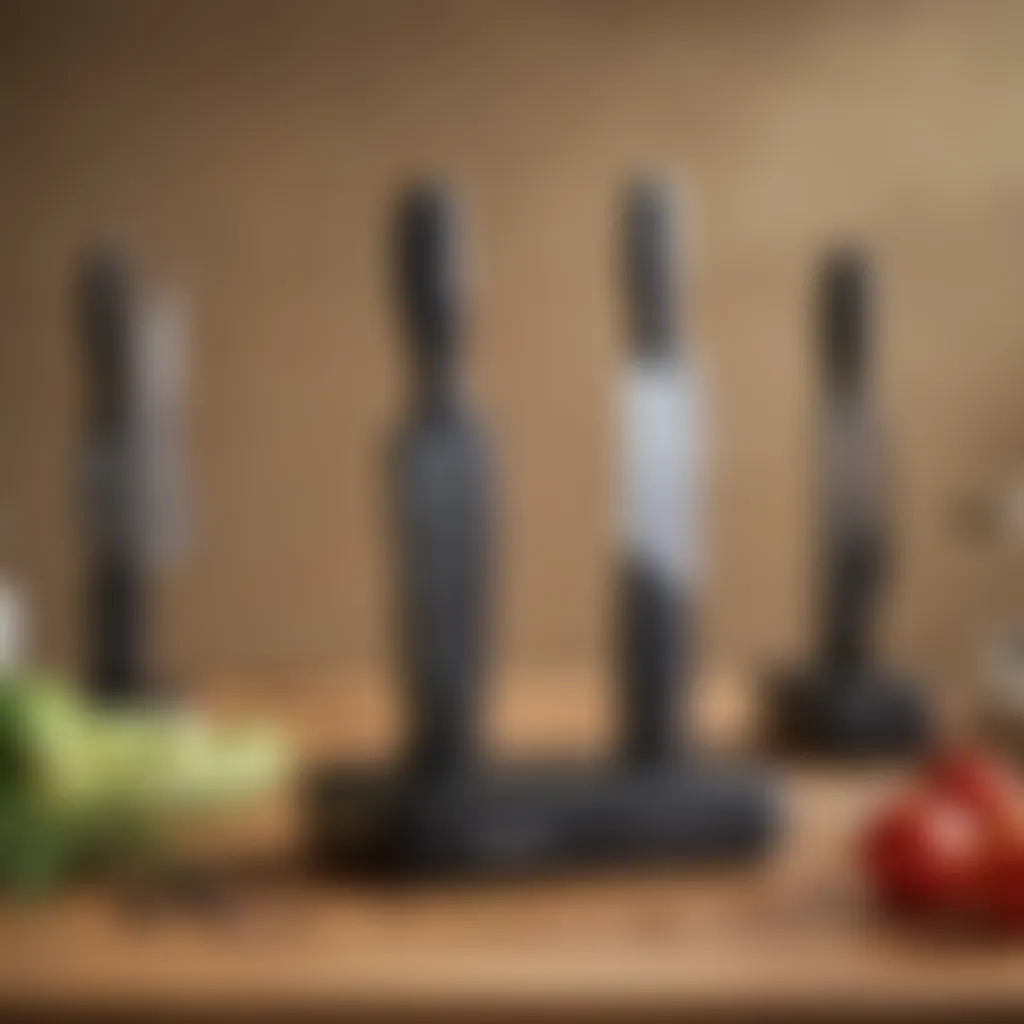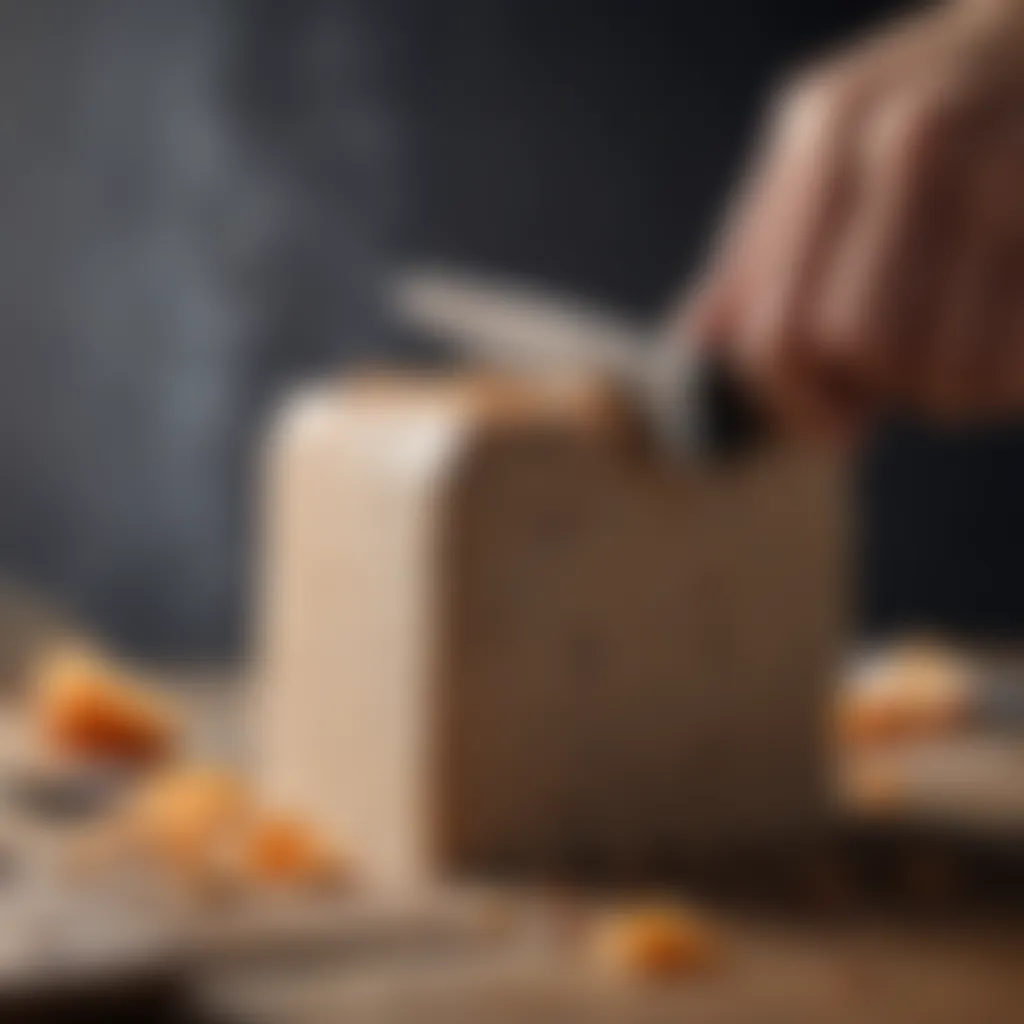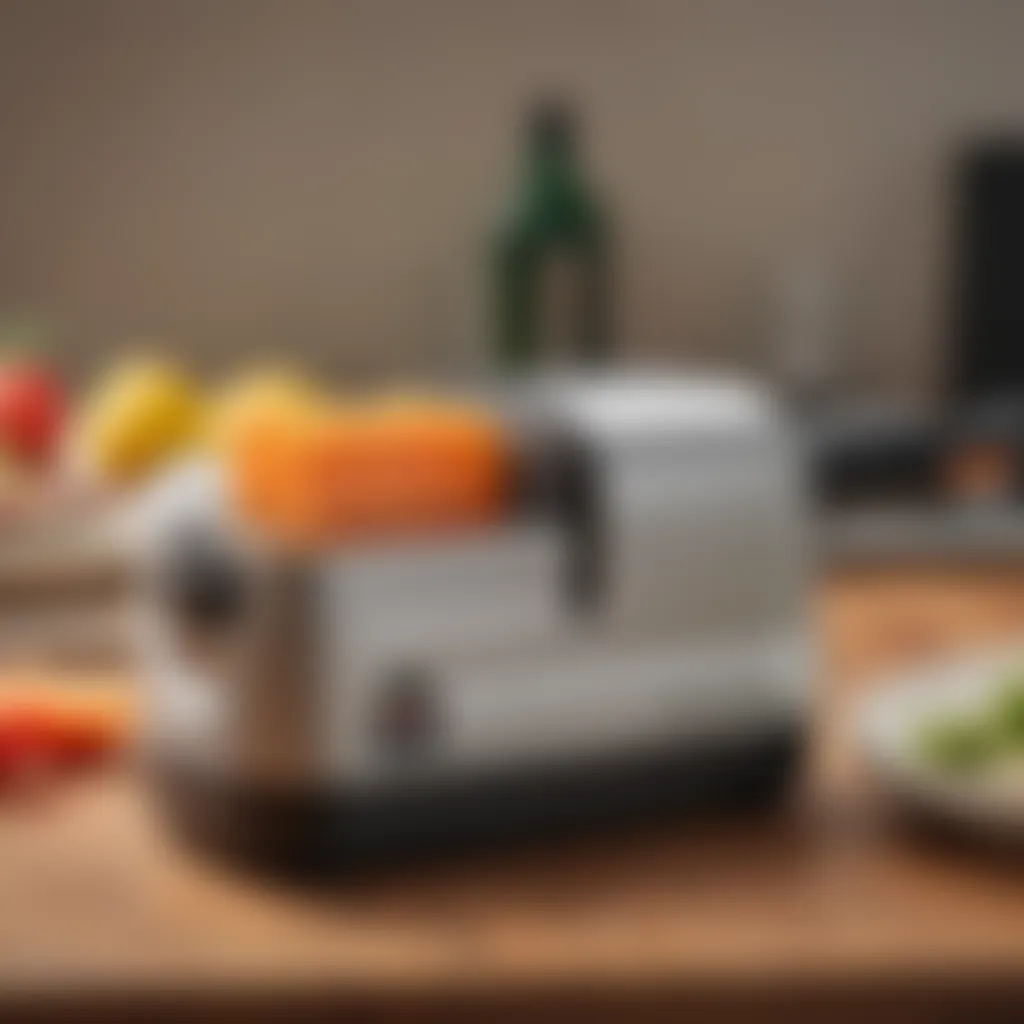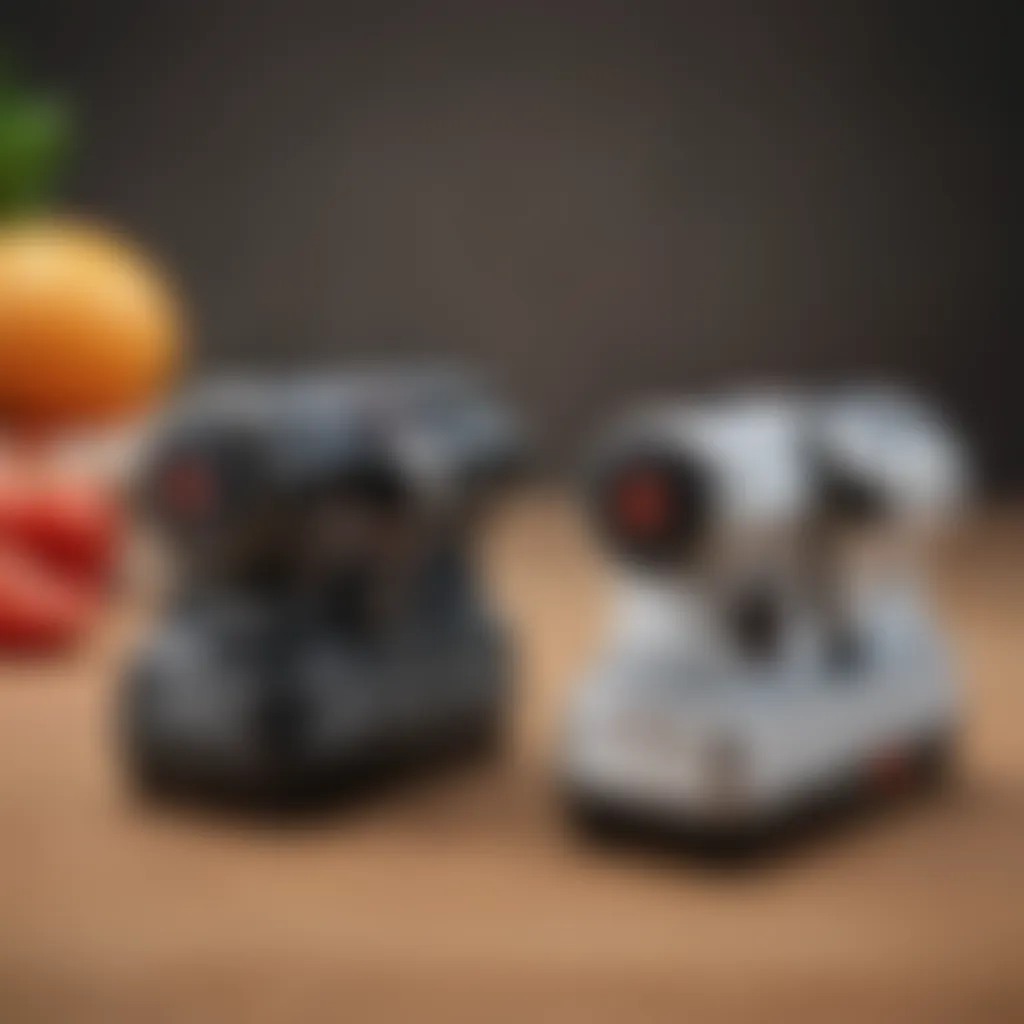Top Kitchen Knife Sharpeners Reviewed for Home Chefs


Intro
In any well-functioning kitchen, the importance of sharp knives cannot be understated. A dull knife not only makes cooking more challenging but also poses safety risks. Using an efficient kitchen knife sharpener is essential for both novice cooks and experienced chefs alike. This article will explore different types of knife sharpeners available on Amazon, comparing their functionalities and ease of use. By the end, you will have a clearer idea of which sharpener best suits your needs.
Ingredients:
When thinking about maintaining your kitchen knives, it's helpful to consider what you need before diving into the specifics of each sharpener. Here’s a basic outline of the key elements to consider:
- Knife Type: Chef's knife, paring knife, bread knife, etc.
- Sharpener Type: Manual, electric, or honing rod.
- Frequency of Use: How often you cook may influence your choice.
- Budget: Set a range for how much you are willing to spend on a sharpener.
Detailed Instructions:
1. Understanding Knife Types
Every knife has a unique design optimized for specific tasks. Familiarize yourself with the primary knives you use in your kitchen.
2. Choosing the Right Sharpener Type
- Manual Sharpeners: These are portable and easy to use. A good choice for casual cooks.
- Electric Sharpeners: More efficient but may cost more. They offer a quick and consistent sharpening process.
- Honing Rods: Not true sharpeners, but useful for maintaining a knife's edge between full sharpenings.
3. Comparing User Reviews
Carefully read user reviews on Amazon about each sharpener. Look for comments on durability, ease of use, and effectiveness.
Technical Aspects:
Consider detailed specifications before making a purchase:
- Sharpening Angles: Typically range from 15 to 20 degrees. Make sure your sharpener is compatible with your knife’s angle.
- Materials Used: Ceramic, diamond, or steel can affect performance.
- Power Settings: For electric sharpeners, varying speed options can be beneficial.
Cooking Process:
Once you have chosen a sharpener, it’s essential to know how to use it effectively.
Step-by-step Sharpening:
- Preparation: Ensure your work area is clean and free of distractions.
- Positioning: Place the sharpener on a stable surface.
- Sharpening: Follow the manufacturer’s instructions closely.
- Testing: After sharpening, test the knife’s sharpness gently on a piece of paper or vegetable.
Troubleshooting Tips:
Common questions or mistakes:
- If your knife is still dull: Double-check the angle and pressure applied during sharpening.
- If there’s a burr on the edge: A honing rod can help remove it.
The End:
Selecting the right knife sharpener can significantly improve your cooking experience. It is crucial to evaluate your needs and understand the features that best suit your culinary habits. By exploring the variety of knife sharpeners on Amazon, you can ensure your knives remain in prime condition, leading to more efficient and safer cooking.
Maintaining your kitchen knives is essential for safety and effectiveness in cooking. Therefore, investing time in choosing the right sharpener is well worth it.
Foreword to Kitchen Knife Sharpeners
Kitchen knife sharpeners are essential tools for maintaining the quality and performance of kitchen knives. A sharp knife is not only safer to use, but it also enhances efficiency while cooking. Dull knives require more force to cut, leading to accidents and potential injuries. Thus, understanding and utilizing the right sharpener can transform one's cooking experience.
Importance of Sharpening
Sharpening is crucial because it restores the cutting edge of kitchen knives. Regular maintenance ensures that knives perform at their best. Cutting with a dull knife can increase the risk of slips and injuries, while a sharp knife allows for precise and effortless slicing. Moreover, maintaining the sharpness of a knife prolongs its lifespan, making sharpening an investment in quality kitchen tools.
"A sharp knife is a chef's best friend."
In addition to safety, efficiency in food preparation is improved significantly with sharp knives. Tasks such as chopping vegetables or filleting fish become quicker and more enjoyable. This efficiency is especially beneficial in busy kitchens where time is of the essence.
Overview of Sharpening Techniques
There are several techniques for sharpening kitchen knives, each with its own merits. Familiarizing oneself with these methods can enhance the sharpening process:


- Manual Sharpening: This traditional method involves using a sharpening stone or whetstone. It requires skill and practice but allows for great control over the sharpening angle.
- Electric Sharpeners: These devices simplify the process with automated options. Though they tend to be quicker, some purists argue that they may remove more material than necessary.
- Honing Rods: These are not actually sharpeners but help maintain the edge between sharpenings. They realign the blade, making it appear sharper.
- Sharpening Stones: Available in various grits, stones enable a thorough sharpening. They require more effort and learning, but many chefs prefer the results they provide.
Each method has its advocates, and the best choice depends on personal preference, skill level, and the specific types of knives owned. Understanding these techniques will help readers make informed decisions when choosing the right sharpener to keep their knives in optimal condition.
Types of Kitchen Knife Sharpeners
Understanding the various types of kitchen knife sharpeners is essential when evaluating the right tool for your needs. Each type offers distinct advantages and considerations, making it important to familiarize yourself with them. From manual options to electric devices, knowing these differences can lead to better knife maintenance and enhanced cooking experiences.
Manual Sharpeners
Manual sharpeners are favored for their simplicity and effectiveness. These devices often consist of two or more sharpening surfaces that require a bit of effort from the user. They typically feature a straight-edge design, making them user-friendly.
Benefits of manual sharpeners include:
- Cost-effective: Usually more affordable compared to electric options.
- Portability: Easy to store and take while traveling.
- Control: Users have greater control over the sharpening process, allowing for personalized sharpening angles.
However, it is important to use proper techniques to avoid damaging the blade. Many users find that honing their skills using a manual sharpener not only keeps their knives sharp but also enhances their understanding of knife maintenance.
Electric Sharpeners
Electric sharpeners represent a more modern approach to knife maintenance. These sharpeners use electrical power to operate, often providing a faster and more efficient sharpening process. Many electric sharpeners come with multiple stages, allowing users to achieve various sharpening grits.
Advantages of electric sharpeners include:
- Efficiency: Sharpens knives quickly and with minimal labor.
- Consistency: Provides uniform sharpening results each time.
- Ease of use: Ideal for those who may struggle with manual sharpening techniques.
Despite these benefits, they can be more expensive and take up more space in the kitchen. Additionally, they may not be suitable for all types of blades, particularly specialized or high-end knives.
Honing Rods
Honing rods, also referred to as sharpening steels, play a slightly different role than traditional sharpeners. They are typically used for realigning the edge of a knife rather than grinding away material. This is an important distinction for maintaining knife sharpness in between deeper sharpening sessions.
Features of honing rods include:
- Material variety: Available in ceramic, diamond, and steel options.
- Precision: Allows for fine-tuning of knife edges, prolonging the need for deeper sharpening.
Using honing rods can extend the lifespan of your kitchen knives and is a practice often recommended by professional chefs. Regular honing can keep your knives in optimal condition, making it an invaluable addition to your knife maintenance routine.
Sharpening Stones
Sharpening stones offer a traditional method for getting knives sharp. Often made of whetstone, these stones can vary in grit from coarse to very fine, catering to different sharpening needs. They are particularly appreciated by enthusiasts and professional chefs alike for their versatility and effectiveness.
Consider the following aspects when using sharpening stones:
- Technique: Requires practice to achieve the right angle and pressure.
- Variety: Different stones available for different blade materials and edge styles.
- Durability: With proper maintenance, stones can last for years.
While sharpening stones do require a learning curve, they can provide superior results once mastered. Their use can become a rewarding ritual for those invested in the culinary arts.
Key Features to Consider
When selecting a kitchen knife sharpener, understanding the key features is essential. These factors not only define the effectiveness of a sharpener but also influence the user experience. Focusing on these elements will lead to a wise investment in a tool that enhances the performance of kitchen knives.
Blade Compatibility
The first consideration must be blade compatibility. Not all sharpeners work for all knives. For example, some sharpeners are designed specifically for Western-style blades, while others suit Asian-style knives. Before buying, check the product description to ensure your existing knives are compatible with the sharpener.
Some sharpeners, like the Work Sharp Guided Field Sharpener, can adapt to a range of blade types and shapes. This feature can prove handy for those who own various knives and prefer using one sharpener for all. Ignoring blade compatibility can lead to suboptimal sharpening experiences and potential blade damage.
Ease of Use
Ease of use should never be overlooked. A complicated sharpener can turn a simple task into a frustrating experience. Look for sharpeners that offer clear instructions and require minimal physical effort. Manual sharpeners require some skill, while electric ones tend to be more user-friendly. For individuals who sharpen frequently, devices like the Chef'sChoice 1520 AngleSelect provide convenience through their simple operation.
Consider how often you are willing to sharpen. If you do not have time for a manual process, an automatic sharpener may be best. Additionally, demonstrations or video reviews can help gauge how easily different models operate.
Safety Features


Safety features are crucial for preventing injury. Look for designs that minimize the risk of cuts. A sharpener with a sturdy non-skid base, like the Presto 08800, ensures stability during use. Similarly, built-in guards on some models protect the fingers from accidental contact with sharp blades.
Using sharp tools always involves some risk, so understanding how a sharpener aids in the safe handling of knives will help you make better decisions. A sharpener that prioritizes user safety can drastically enhance the overall sharpening experience.
Portability
Portability can be a deciding factor, especially for those who may want to sharpen knives during camping trips or picnics. Small, compact sharpeners are preferable in these situations. Models such as the Smith's Pocket Pal are lightweight and can fit easily in a backpack. This aspect becomes even more important for those who travel or often cook in different settings.
In addition to being lightweight, consider how easy it is to store or whether the sharpener comes with a protective case. A tool that can travel with ease while also securing the blades will always be a beneficial choice.
In summary, when choosing a knife sharpener, ask yourself: is it compatible with my knives? How convenient is it to use? Are there safety features in place? And can I take it with me if necessary? Understanding these key features will lead to a sharper, more effective kitchen experience.
Top Amazon Kitchen Knife Sharpeners
When it comes to maintaining knives, finding the right sharpener is crucial. Top Amazon kitchen knife sharpeners stand out because they combine affordability, functionality, and a diverse range of choices. Each model available on the platform has unique features suited for different knife types. Knowing what is available helps consumers make educated decisions.
Detailed Reviews of Bestsellers
The bestsellers in the knife sharpener category on Amazon typically share a common trait: they have proven their effectiveness through numerous user reviews and high ratings. For instance, the Chef'sChoice 15 Trizor XV is often highlighted for its three-stage sharpening system. This sharpener is compatible with both straight and serrated knives, making it versatile.
Another notable option is the Work Sharp Guided Field Sharpener. This is a portable and compact sharpener, perfect for those who need quick touch-ups. It also features a ceramic honing rod and a diamond plate, catering to outdoor enthusiasts and home cooks alike. Customer reviews frequently mention its ease of use and effectiveness, reinforcing its position as a top choice.
Other popular models include the Lansky Deluxe 5-Stone Sharpening System, which allows for precise sharpening angles and is ideal for more hands-on users, and the AccuSharp Knife Sharpener, which is appreciated for its simplicity and affordability. Each of these sharpeners has its own strengths, appealing to different preferences and knife maintenance practices.
Comparison of Features
When comparing knife sharpeners, several key features come into play:
- Sharpening Method: Some sharpeners use a manual method while others are electric. Manuals like the Lansky system allow for more control, while electric models often provide speed.
- Blade Compatibility: It's essential to check whether the sharpener can handle different types of blades. Models such as the Chef'sChoice accommodate both straight and serrated blades, increasing their utility.
- Ease of Use: User-friendliness is vital. Electric sharpeners often have clear guides, whereas manual ones may require more skill.
- Portability: For those who travel or need sharp knives in various settings, portable sharpeners such as the Work Sharp are ideal. They fit easily into bags and lend themselves well to on-the-go sharpening.
In summary, an informed choice in kitchen knife sharpeners on Amazon can significantly impact the longevity and performance of kitchen knives. Exploring top options ensures users find tools that fit their needs perfectly.
User Reviews and Ratings
User reviews and ratings are a significant component in evaluating kitchen knife sharpeners on Amazon. They provide insights from actual users who have tested the products in their own kitchens. Understanding how a sharpener performs in practical situations can be more enlightening than manufacturer descriptions alone.
When searching for the right sharpener, potential buyers should pay attention to several specific elements in the reviews. Positive remarks often highlight effectiveness, ease of use, and overall satisfaction. Conversely, critical reviews will typically address dissatisfaction points. This analysis helps build a balanced perspective before making a purchase.
Benefits of User Reviews
- Real-World Feedback: Provides applicable insights based on everyday experiences.
- Diversity of Opinions: Readers can learn how various users—from beginners to seasoned chefs—rate a sharpener.
- Product Reliability: A higher number of positive reviews usually signals a reliable product.
- Potential Issues: Identifying consistent complaints can save buyers from poor purchases.
Incorporating user ratings into the decision-making process brings value and clarity. Reading multiple reviews can deepen one's understanding of a product's pros and cons. This helps in making an informed choice that better suits individual needs.
What Users are Saying
Many users express their satisfaction with sharpener performance in detail. Customers often comment on specific features that make a sharpener easy to use. For example, the Chef’sChoice Trizor XV edges have received praise for their 15-degree angle, producing sharp edges that enhance cutting precision. Furthermore, sharpener works quickly, saving users valuable time in food preparation.
Additionally, many reviewers emphasize the convenience of electric sharpeners, like the Work Sharp Guided, which combines ease of use with effective results. Users have pointed out how these models reduce the learning curve, enabling even novice cooks to achieve excellent results without prior experience.
Common Complaints
While user reviews highlight the strong points of various sharpeners, they also reveal notable complaints. Some reviewers mention that certain models can be less effective on high-end knives, particularly those made of harder steel, like Shun or Global brands. Users have reported that these sharpeners may not maintain the sharpness for long periods.
Another common issue is related to safety. Some manual sharpeners, though effective, can create concerns about hand safety. In particular, reviewers have commented on difficulty controlling the blade if not used properly. Moreover, the durability of some products is brought into question. Reviews for certain economy models highlight that they may wear out quickly with frequent use.
Understanding these concerns can guide consumers in their choices. Overall, reading through user reviews will help in making a secure decision about which kitchen knife sharpener to select.
Price Range Analysis
Understanding the price range of kitchen knife sharpeners is vital for making an informed purchasing decision. Each segment in the pricing spectrum—affordable, mid-range, and premium—offers distinct advantages and caters to different user needs. By analyzing price ranges, readers can tailor their choices according to their budget while also ensuring they receive the quality and functionality aligned with their culinary activities.
The importance of this analysis lies in recognizing what features are available at each price point. Budget options may lack certain advanced features but can still effectively sharpen knives. Mid-range choices often balance quality and price, presenting a multitude of capabilities for home cooks. Lastly, premium models typically offer exceptional durability and advanced technology, appealing to serious chefs who demand precision and longevity. All these factors influence not just the initial outlay but also the long-term performance and satisfaction each user anticipates.
Affordable Options


When looking for affordable kitchen knife sharpeners, it is essential to focus on brands like Smith's and AccuSharp. These offerings usually range from $10 to $30. Although they may lack advanced features, they still effectively restore dull blades. Simplicity and effectiveness often define them.
Key features to expect:
- Manual or handheld design for easy use
- Basic sharpening mechanisms, such as carbide and ceramic
- Lightweight construction for portability
These affordable options are not just for novices. Even seasoned cooks can use them for quick touch-ups when needed, staying productive in the kitchen.
Mid-Range Choices
Mid-range kitchen knife sharpeners often offer a blend of quality, functionality, and price. Brands such as Chef'sChoice and Wüsthof fall into this category, with prices typically between $30 to $100. These sharpeners provide a comprehensive sharpening system, often incorporating multiple stages or materials for varied blade types.
Benefits of choosing mid-range products include:
- Enhanced sharpening technology for better results
- Durability, often with higher-quality materials
- Greater versatility, including features for serrated knives and scissors
Investing in a mid-range sharpener can yield significant returns, as these tools keep knives in optimal condition, enhancing both safety and efficiency in meal preparation.
Premium Models
Premium kitchen knife sharpeners feature high-end brands like Work Sharp and Shun. Their prices usually start from $100 and can exceed several hundreds. These models are designed for serious kitchen enthusiasts or professional chefs who require advanced performance.
Notable characteristics of premium models include:
- Automated sharpening processes for consistency
- Advanced systems that can sharpen various knife types, including specialty blades
- Longevity, with warranties often extending for years
While the initial price is higher, buyers of premium sharpeners can expect excellent, long-lasting results. They become an investment in quality, positively impacting one's culinary experience for years to come.
"Quality kitchen knife sharpeners can transform meal prep from a chore into a satisfying experience."
Understanding the price range and corresponding features helps users choose a kitchen knife sharpener that fits their needs and budget. A careful assessment ensures satisfaction in both performance and value.
Maintenance and Care Tips
Proper maintenance of kitchen knife sharpeners is essential for ensuring they remain effective and safe to use. Just as you care for your knives, it is important to maintain the tools that sharpen them. Having a clean and well-stored sharpener will not only prolong its lifespan but also enhance its performance. This article will examine how to properly clean your sharpeners and offer storage recommendations to keep them in optimal condition.
Proper Cleaning
Cleaning your kitchen knife sharpener after each use is crucial. Food particles and metal filings can accumulate over time, affecting the sharpener’s effectiveness. To maintain optimal performance, follow these cleaning steps:
- Immediate Cleaning: After using the sharpener, wipe the surfaces with a dry cloth to remove particles.
- Regular Deep Cleaning: Periodically, disassemble the sharpener (if possible) and use warm soapy water to clean the various parts. Be careful to rinse thoroughly and dry completely before reassembling.
- Avoid Abrasives: Refrain from using abrasive cleaners or sponges that could scratch the sharpening surface. A soft cloth or sponge is recommended.
Also, check and clean any sharpening wells or grooves carefully. Sometimes, a toothbrush can reach crevices better. Keeping your sharpener clean will lead to safer and more efficient sharpening.
Remember, a clean sharpener is a more effective sharpener.
Storage Recommendations
Storing your knife sharpener properly is just as important as cleaning it. Improper storage can lead to damage, dulling of sharpening surfaces, or accidents in the kitchen. Consider these storage tips:
- Dry Environment: Always store your sharpener in a dry area to prevent rust or corrosion. Moisture can deteriorate some materials.
- Safe Location: Place the sharpener in a safe location, out of reach of children. Avoid high shelves where it can fall or be knocked over.
- Use Original Packaging: If possible, store the sharpener in its original packaging to shield it from dust and potential damage.
- Dedicated Drawer or Container: Have a specific drawer or container for your sharpening tools. This prevents chaos and ensures they are easily accessible when needed.
These maintenance and storage tips offer a practical approach to care for kitchen knife sharpeners. Adopting these habits will lead to higher performance and a longer lifespan for your sharpening tools.
Culmination
In wrapping up this exploration of kitchen knife sharpeners, it is essential to highlight the myriad advantages that a proper sharpener can bring to your culinary experience. A well-sharpened knife enhances not only the efficiency of your food preparation but also the overall enjoyment of your cooking adventures. Without the right tool, cooking can quickly turn from an enjoyable task into a frustrating ordeal. Investing in a quality sharpener ensures that your knives will consistently perform at their best, allowing you to slice through ingredients with precision and ease.
Recap of Key Points
Throughout this article, we have delved into various aspects of kitchen knife sharpeners available on Amazon. Here’s a summary of the key takeaways:
- Types of Sharpeners: We explored the main types including manual, electric, honing rods, and sharpening stones. Each type offers unique benefits tailored to different user preferences.
- Key Features to Consider: It is vital to review attributes such as blade compatibility, ease of use, safety features, and portability when selecting a sharpener that suits your needs.
- User Reviews and Ratings: By examining feedback from other users, you can gain insights that guide your purchasing decision and highlight common issues to be wary of.
- Price Range Analysis: This aspect covers affordable, mid-range, and premium options, providing choices aligned with various budgets and expectations.
- Maintenance and Care Tips: General upkeep will increase the longevity of both the sharpeners and your knives, further enhancing your culinary toolset.
Making an Informed Choice
Choosing the right kitchen knife sharpener is a decision that impacts not just your cooking efficiency, but also your investment in high-quality knives. With the variety of available sharpeners, consider your individual needs carefully.
- Usage Frequency: If you're a frequent cook, an electric sharpener may be beneficial for routine maintenance. Alternatively, casual cooks might find manual sharpeners or honing rods sufficient.
- Knife Types: Ensure your selected sharpener can handle the blade styles you have, such as ceramic or stainless steel.
- Personal Preference: Some may appreciate the control offered by manual sharpeners while others may prefer the convenience of electric options.
A well-thought-out approach to selecting the suitable sharpener can save you time, money, and frustration. By reflecting on the details discussed, you can make an informed decision that aligns with your cooking style.







